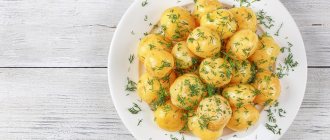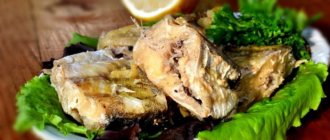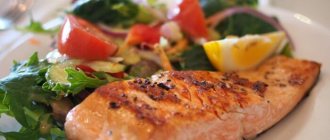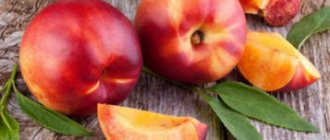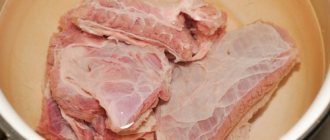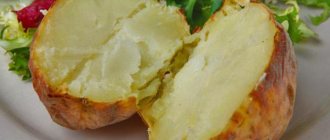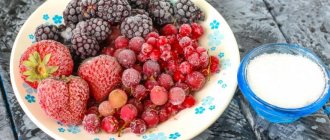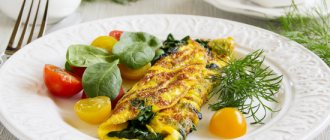Steamed potatoes calorie content. How many calories are in potatoes
Potatoes are a tuberous vegetable, which is rightly called the second bread.
It has high taste properties and is easy to cook. The benefits of potatoes depend on the method of preparing the dish. Thus, steaming and peeling, baking help preserve vitamins and mineral salts, and mashed potatoes and soufflé reduce mechanical irritation of the gastric mucosa. These and other qualities have found their application in dietary nutrition: The calorie content of 100 g of potatoes is on average 80 kcal, but depending on the cooking method it can vary significantly. For example, 100 g of mashed potatoes gives 74 kcal, and fried potatoes - 192 kcal.
The negative properties of potatoes include:
If you need to calculate the calorie content of a complex dish that includes potatoes, indicate its weight in grams in the “Vegetables, herbs, herbs, fresh roots” section.
Ingredients Steamed Potatoes
Nutritional value and chemical composition of “Steamed Potatoes”.
| Nutrient | Quantity | Norm** | % of the norm in 100 g | % of the norm in 100 kcal | 100% normal |
| Calorie content | 75.1 kcal | 1684 kcal | 4.5% | 6% | 2242 g |
| Squirrels | 1.979 g | 76 g | 2.6% | 3.5% | 3840 g |
| Fats | 0.404 g | 56 g | 0.7% | 0.9% | 13861 g |
| Carbohydrates | 15.845 g | 219 g | 7.2% | 9.6% | 1382 g |
| Organic acids | 0.186 g | ||||
| Alimentary fiber | 1.4 g | 20 g | 7% | 9.3% | 1429 g |
| Water | 79 g | 2273 g | 3.5% | 4.7% | 2877 g |
| Vitamins | |||||
| Vitamin A, RE | 3.1 mcg | 900 mcg | 0.3% | 0.4% | 29032 g |
| beta carotene | 0.021 mg | 5 mg | 0.4% | 0.5% | 23810 g |
| Vitamin B1, thiamine | 0.111 mg | 1.5 mg | 7.4% | 9.9% | 1351 g |
| Vitamin B2, riboflavin | 0.065 mg | 1.8 mg | 3.6% | 4.8% | 2769 g |
| Vitamin B5, pantothenic | 0.309 mg | 5 mg | 6.2% | 8.3% | 1618 g |
| Vitamin B6, pyridoxine | 0.309 mg | 2 mg | 15.5% | 20.6% | 647 g |
| Vitamin B9, folates | 8.247 mcg | 400 mcg | 2.1% | 2.8% | 4850 g |
| Vitamin C, ascorbic acid | 14.43 mg | 90 mg | 16% | 21.3% | 624 g |
| Vitamin E, alpha tocopherol, TE | 0.103 mg | 15 mg | 0.7% | 0.9% | 14563 g |
| Vitamin H, biotin | 0.103 mcg | 50 mcg | 0.2% | 0.3% | 48544 g |
| Vitamin RR, NE | 1.8557 mg | 20 mg | 9.3% | 12.4% | 1078 g |
| Macronutrients | |||||
| Potassium, K | 527.01 mg | 2500 mg | 21.1% | 28.1% | 474 g |
| Calcium, Ca | 9.79 mg | 1000 mg | 1% | 1.3% | 10215 g |
| Magnesium, Mg | 22.53 mg | 400 mg | 5.6% | 7.5% | 1775 g |
| Sodium, Na | 4.38 mg | 1300 mg | 0.3% | 0.4% | 29680 g |
| Sera, S | 32.99 mg | 1000 mg | 3.3% | 4.4% | 3031 g |
| Phosphorus, P | 55 mg | 800 mg | 6.9% | 9.2% | 1455 g |
| Chlorine, Cl | 59.79 mg | 2300 mg | 2.6% | 3.5% | 3847 g |
| Microelements | |||||
| Bor, B | 118.6 mcg | ||||
| Iron, Fe | 0.854 mg | 18 mg | 4.7% | 6.3% | 2108 g |
| Yod, I | 5.15 mcg | 150 mcg | 3.4% | 4.5% | 2913 g |
| Cobalt, Co | 5.155 mcg | 10 mcg | 51.6% | 68.7% | 194 g |
| Manganese, Mn | 0.1753 mg | 2 mg | 8.8% | 11.7% | 1141 g |
| Copper, Cu | 144.33 mcg | 1000 mcg | 14.4% | 19.2% | 693 g |
| Molybdenum, Mo | 8.247 mcg | 70 mcg | 11.8% | 15.7% | 849 g |
| Selenium, Se | 0.309 mcg | 55 mcg | 0.6% | 0.8% | 17799 g |
| Fluorine, F | 30.93 mcg | 4000 mcg | 0.8% | 1.1% | 12932 g |
| Chromium, Cr | 10.31 mcg | 50 mcg | 20.6% | 27.4% | 485 g |
| Zinc, Zn | 0.3711 mg | 12 mg | 3.1% | 4.1% | 3234 g |
The energy value of steamed potatoes is 75.1 kcal.
Primary Source: Created in the application by the user. Read more.
** This table shows the average levels of vitamins and minerals for an adult. If you want to know the norms taking into account your gender, age and other factors, then use the “My Healthy Diet” application.
The benefits of boiled potatoes and how many calories are in boiled potatoes
First of all, this dish will be useful if the doctor has prescribed you to limit your consumption of starch. For whatever reason. The fact is that when you boil potatoes, a significant part of the starch goes into the water. Naturally, the one in which the potatoes are boiled. And when the potatoes are ready, you just need to drain the water from them to get a healthy and dietary dish.
And for those who want to get rid of extra pounds, boiled potatoes can be of real help. Mashed potatoes with green dill and yogurt are especially useful in this case. Although many nutritionists recommend limiting the consumption of potatoes for overweight people, since this vegetable is very rich in starch. And potatoes contain three times more calories than other vegetables. But even if you have extra pounds and you really want to lose weight, you shouldn’t completely remove this vegetable from your diet. After all, it has a lot of useful substances that are extremely necessary for the human body. In particular, it is rich in amino acids and vitamin C.
And not only vitamin C. There are also B vitamins - B, B2, B6. There are also vitamins PP, D, E, as well as carotene and folic acid. Potatoes are not deprived of macro and microelements - phosphorus, magnesium, iron and calcium. But this vegetable is especially rich in potassium. It contains more than 500 mg of this element. per hundred grams of product. Potassium is very useful when you need to remove salts from the human body, which is very useful for the cardiovascular system and when you need to eliminate edema. In addition, potatoes can help remove bad cholesterol from the body and lower blood pressure.
It’s not for nothing that many nutritionists recommend their patients to do potato fasting days. This not only helps normalize weight, but also helps prevent circulatory disorders, kidney diseases and normalize blood pressure. On such a day, it is recommended to eat only boiled potatoes.
Calorie content of boiled potatoes
The simplest and most dietary way to prepare potatoes is boiling. The calorie content of boiled potatoes without peel is about 86 kilocalories per 100 grams.
A widely used method is boiling potatoes in their skins - “in their jackets”. In this case, the calorie content of boiled potatoes is 78 kilocalories per 100 grams. Of course, there is no real difference in energy value between boiled potatoes with and without peels. There will be the same amount of calories in jacket potatoes, but the weight of the dish due to the inedible part will be slightly greater. Still, nutritionists advise boiling potatoes with their skins on. This helps preserve more of the beneficial properties of the vegetable. After all, potatoes are considered the most accessible source of antioxidants, potassium, phosphorus and ascorbic acid.
The calorie content of boiled potatoes is lower than that of many other products. For example, bread, buckwheat porridge, pasta, and bananas are superior in calories to potatoes. However, in order not to harm your figure, boiled potatoes should be eaten without butter, sour cream or mayonnaise. It's best not to use any sauces at all. It is the fat from these additives that increases the calorie content of potato dishes.
Potato calorie table
| Name of the dish | Number of calories (kcal) per 100 g. |
| Boiled | |
| In uniform | 77 |
| Without peel | 80 |
| Young without skin | 66 |
| With butter | 127 |
| Young with butter and herbs | 84 |
| With fried onions | 125 |
| Puree | |
| With milk | 97 |
| With butter and milk | 133 |
| With fried mushrooms | 102 |
| With fried lard | 171 |
| Baked | |
| In uniform | 80 |
| Without peel | 77 |
| Country style | 117 |
| Fried | |
| With vegetable oil | 204 |
| In lard | 212 |
| Stewed with chicken and vegetables | 145 |
| Fries | 312 |
| Potato dishes | |
| Potato soup | 40 |
| Casserole | 110 |
| Fried pies | 185 |
| Baked pies | 150 |
| Draniki (pancakes) | 268 |
| Zrazy | 268 |
| Vareniki | 148 |
| Chips | |
| "Lays" | 510 |
| "Estrella" | 518 |
| "Pringles" | 540 |
| Homemade in the microwave | 118 |
| Baby potato | |
| With dill and vegetable oil | 128 |
| Baked with meat | 130 |
| Baked with cheese | 115 |
| Baked with cheese and butter | 158 |
| Chicken gratin | 261 |
So, the calorie content of potatoes is not as high as everyone thinks. It turns out that we ourselves increase it with the help of various sauces and seasonings.
It’s hard to imagine what the Russian table would be like without potatoes. But in order to once spread this culture, significant efforts were required. In the “pre-potato” period, cabbage, turnips, beets and other vegetables, which have a fundamentally different chemical composition, were held in high esteem. In particular, potato tubers have a high water content (up to 77%) and starch (17.5%). In addition, the tubers contain sugars, proteins, mineral salts and vitamins K, PP, B1, B6, B2.
Potato proteins (tuberins, glutamines) are not much inferior to the proteins of eggs or meat products in biological significance. They include essential amino acids and are presented in a successful combination. But the protein component has almost no effect on how many calories are in boiled potatoes, since in percentage terms it occupies about 1-2 percent of the total volume of the product. But starch, which provides carbohydrates (up to 20 grams per 100 grams of potatoes), primarily determines the nutritional value of tubers.
How many calories are in boiled potatoes? This depends on the type of tubers, the period and conditions of their storage. There are potatoes with high dry matter content (25-29%), medium (up to 25 percent) and low (below 22%). The higher the dry matter level, the more starch the product contains. This indicator is also affected by low temperature (about 2 degrees Celsius) and long shelf life. These parameters reduce the level of starch, converting it, however, into various types of sugars.
Recipe: Steamed potatoes. Calorie, chemical composition and nutritional value.
Nutritional value and chemical composition of “Steamed Potatoes”.
The table shows the nutritional content (calories, proteins, fats, carbohydrates, vitamins and minerals) per 100 grams of edible portion.
| Nutrient | Quantity | Norm** | % of the norm in 100 g | % of the norm in 100 kcal | 100% normal |
| Calorie content | 76.8 kcal | 1684 kcal | 4.6% | 6% | 2193 g |
| Squirrels | 2 g | 76 g | 2.6% | 3.4% | 3800 g |
| Fats | 0.4 g | 56 g | 0.7% | 0.9% | 14000 g |
| Carbohydrates | 16.2 g | 219 g | 7.4% | 9.6% | 1352 g |
| Organic acids | 0.2 g | ~ | |||
| Alimentary fiber | 1.5 g | 20 g | 7.5% | 9.8% | 1333 g |
| Water | 78.1 g | 2273 g | 3.4% | 4.4% | 2910 g |
| Ash | 1.024 g | ~ | |||
| Vitamins | |||||
| Vitamin A, RE | 3.2 mcg | 900 mcg | 0.4% | 0.5% | 28125 g |
| alpha carotene | 0.037 mcg | ~ | |||
| beta carotene | 0.022 mg | 5 mg | 0.4% | 0.5% | 22727 g |
| beta Cryptoxanthin | 0.078 mcg | ~ | |||
| Lycopene | 0.062 mcg | ~ | |||
| Lutein + Zeaxanthin | 1.41 mcg | ~ | |||
| Vitamin B1, thiamine | 0.113 mg | 1.5 mg | 7.5% | 9.8% | 1327 g |
| Vitamin B2, riboflavin | 0.066 mg | 1.8 mg | 3.7% | 4.8% | 2727 g |
| Vitamin B4, choline | 11.51 mg | 500 mg | 2.3% | 3% | 4344 g |
| Vitamin B5, pantothenic | 0.317 mg | 5 mg | 6.3% | 8.2% | 1577 g |
| Vitamin B6, pyridoxine | 0.314 mg | 2 mg | 15.7% | 20.4% | 637 g |
| Vitamin B9, folates | 8.401 mcg | 400 mcg | 2.1% | 2.7% | 4761 g |
| Vitamin C, ascorbic acid | 14.61 mg | 90 mg | 16.2% | 21.1% | 616 g |
| Vitamin E, alpha tocopherol, TE | 0.108 mg | 15 mg | 0.7% | 0.9% | 13889 g |
| gamma tocopherol | 0.02 mg | ~ | |||
| Vitamin H, biotin | 0.104 mcg | 50 mcg | 0.2% | 0.3% | 48077 g |
| Vitamin K, phylloquinone | 2.5 mcg | 120 mcg | 2.1% | 2.7% | 4800 g |
| Vitamin RR, NE | 1.7316 mg | 20 mg | 8.7% | 11.3% | 1155 g |
| Niacin | 1.221 mg | ~ | |||
| Betaine | 0.028 mg | ~ | |||
| Macronutrients | |||||
| Potassium, K | 537.55 mg | 2500 mg | 21.5% | 28% | 465 g |
| Calcium, Ca | 11.29 mg | 1000 mg | 1.1% | 1.4% | 8857 g |
| Silicon, Si | 52.174 mg | 30 mg | 173.9% | 226.4% | 57 g |
| Magnesium, Mg | 23.33 mg | 400 mg | 5.8% | 7.6% | 1715 g |
| Sodium, Na | 4.5 mg | 1300 mg | 0.3% | 0.4% | 28889 g |
| Sera, S | 33.39 mg | 1000 mg | 3.3% | 4.3% | 2995 g |
| Phosphorus, P | 56.2 mg | 800 mg | 7% | 9.1% | 1423 g |
| Chlorine, Cl | 60.52 mg | 2300 mg | 2.6% | 3.4% | 3800 g |
| Microelements | |||||
| Aluminium, Al | 897.4 mcg | ~ | |||
| Bor, B | 120 mcg | ~ | |||
| Vanadium, V | 155.48 mcg | ~ | |||
| Iron, Fe | 0.894 mg | 18 mg | 5% | 6.5% | 2013 |
| Yod, I | 5.31 mcg | 150 mcg | 3.5% | 4.6% | 2825 g |
| Cobalt, Co | 5.217 mcg | 10 mcg | 52.2% | 68% | 192 g |
| Lithium, Li | 80.348 mcg | ~ | |||
| Manganese, Mn | 0.217 mg | 2 mg | 10.9% | 14.2% | 922 g |
| Copper, Cu | 150.22 mcg | 1000 mcg | 15% | 19.5% | 666 g |
| Molybdenum, Mo | 8.348 mcg | 70 mcg | 11.9% | 15.5% | 839 g |
| Nickel, Ni | 5.217 mcg | ~ | |||
| Rubidium, Rb | 521.7 mcg | ~ | |||
| Selenium, Se | 0.295 mcg | 55 mcg | 0.5% | 0.7% | 18644 g |
| Strontium, Sr | 9.68 mcg | ~ | |||
| Fluorine, F | 31.41 mcg | 4000 mcg | 0.8% | 1% | 12735 g |
| Chromium, Cr | 10.43 mcg | 50 mcg | 20.9% | 27.2% | 479 g |
| Zinc, Zn | 0.3793 mg | 12 mg | 3.2% | 4.2% | 3164 g |
| Zirconium, Zr | 3.16 mcg | ~ | |||
| Digestible carbohydrates | |||||
| Starch and dextrins | 15.026 g | ~ | |||
| Mono- and disaccharides (sugars) | 1 g | max 100 g | |||
| Glucose (dextrose) | 0.627 g | ~ | |||
| Sucrose | 0.626 g | ~ | |||
| Fructose | 0.105 g | ~ | |||
| Essential amino acids | 0.751 g | ~ | |||
| Arginine* | 0.105 g | ~ | |||
| Valin | 0.129 g | ~ | |||
| Histidine* | 0.032 g | ~ | |||
| Isoleucine | 0.091 g | ~ | |||
| Leucine | 0.137 g | ~ | |||
| Lysine | 0.142 g | ~ | |||
| Methionine | 0.027 g | ~ | |||
| Methionine + Cysteine | 0.052 g | ~ | |||
| Threonine | 0.102 g | ~ | |||
| Tryptophan | 0.029 g | ~ | |||
| Phenylalanine | 0.104 g | ~ | |||
| Phenylalanine+Tyrosine | 0.198 g | ~ | |||
| Nonessential amino acids | 1.223 g | ~ | |||
| Alanin | 0.103 g | ~ | |||
| Aspartic acid | 0.265 g | ~ | |||
| Glycine | 0.106 g | ~ | |||
| Glutamic acid | 0.278 g | ~ | |||
| Proline | 0.1 g | ~ | |||
| Serin | 0.135 g | ~ | |||
| Tyrosine | 0.095 g | ~ | |||
| Cysteine | 0.024 g | ~ | |||
| Sterols (sterols) | |||||
| Phytosterols | 0.286 mg | ~ | |||
| Saturated fatty acids | |||||
| Saturated fatty acids | 0.1 g | max 18.7 g | |||
| 14:0 Miristinovaya | 0.002 g | ~ | |||
| 16:0 Palmitinaya | 0.076 g | ~ | |||
| 18:0 Stearic | 0.017 g | ~ | |||
| Monounsaturated fatty acids | 0.172 g | min 16.8 g | 1% | 1.3% | |
| 16:1 Palmitoleic | 0.005 g | ~ | |||
| 18:1 Oleic (omega-9) | 0.169 g | ~ | |||
| 18:1 cis | 0.002 g | ~ | |||
| Polyunsaturated fatty acids | 0.087 g | from 11.2 to 20.6 g | 0.8% | 1% | |
| 18:2 Linolevaya | 0.086 g | ~ | |||
| 18:3 Linolenic | 0.086 g | ~ | |||
| Omega-3 fatty acids | 0.1 g | from 0.9 to 3.7 g | 11.1% | 14.5% | |
| Omega-6 fatty acids | 0.1 g | from 4.7 to 16.8 g | 2.1% | 2.7% |
The energy value of steamed potatoes is 76.8 kcal.
Primary Source: Created in the application by the user. Read more.
** This table shows the average levels of vitamins and minerals for an adult. If you want to know the norms taking into account your gender, age and other factors, then use the “My Healthy Diet” application.
Calorie content of boiled potatoes
Potatoes boiled in milk – 97.2 kcal.
Boiled potatoes with mushrooms – 102 kcal.
Dumplings with potatoes – 110 kcal.
French fries – 350 kcal.
For baking in their skins, it is better to choose medium-sized potatoes, otherwise there is a chance that the tuber will not bake in the middle, but will already burn at the edges. In order to save time, you should give preference to small fruits - they cook much faster.
Thanks to the peel, potatoes cooked in their jackets retain mineral salts and organic acids. It is rich in potassium and magnesium, ideal for diet.
Three hundred grams of boiled product contains the daily requirement of carbohydrates, potassium and phosphorus. But if you store it for more than three months, the properties of the nutrients in it decrease. The content of vitamin C especially decreases - only a third of the original amount remains.
Potatoes must be supplemented with protein-rich foods. This vegetable goes perfectly with meat or mushrooms, and the protein content in such dishes increases.
If you fry potatoes with mushrooms, the calorie content of the dish will not exceed 120 kilocalories per 100 g. It should be remembered: adding a large amount of oil significantly increases the calorie content of the dish.
Potatoes with mushrooms go well with sour cream. When baking such a dish with sour cream 30% fat, only 100 kilocalories per 100 g. When using sour cream with less fat, the total calorie content of the dish is reduced. This is a very tasty and healthy way to cook potatoes.
Meat and potatoes in the oven is a great recipe for the holiday table. And in one hundred grams there are only 100 kilocalories. Using fatty meat increases the calorie content of such pots. For those who want to lose weight or just keep in shape, it is better to give preference to lean beef or pork.
Due to their low calorie content, potatoes are dietary. There are a huge number of low-calorie recipes with this vegetable: casseroles, pots, stews, baked or simply boiled potatoes. Potatoes combined with meat are a source of energy for the whole day.
But you should not overuse dishes made from this vegetable, because they are rich in carbohydrates. People who care about their figure should give preference to protein products for dinner - meat, fish, eggs. And potatoes can act as a side dish at lunchtime. The glycemic index of this product is high, so people with diabetes and pancreatic disease need to be extremely careful.
Potatoes are a perennial root crop of the nightshade family; all above-ground parts of the plant, especially the berries, are poisonous due to the high content of the toxic glycoside solanine.
The combination of unpretentiousness in cultivation and the satiety of dishes prepared from it made potatoes accessible to all segments of the population. Lost harvests due to late blight caused widespread famine in Ireland in the 19th century.
At the end of the 17th century, Peter the Great sent root crops from Holland to Russia for planting and cultivation in Russian provinces. The idea of growing earthen apples did not catch on right away; many, out of ignorance, poisoned themselves with the fruits of the plant and dubbed them devilish, and even rebelled against them.
Calorie content of fried potatoes
Fried potatoes are incredibly tasty, but how filling they are! In order to “neutralize” it, you will need at least an hour of physical exercise or at least brisk walking. Calorie content of 100 grams of fried potatoes:
- with vegetable oil – 203 kcal;
- on pork lard (cracklings) – 212 kcal;
- on melted lard – 224 kcal;
- French fries - 305 kcal (at McDonald's - up to 500 kcal, calorie content depends on the time the slices are in the deep fryer).
As you can see, 100 grams of fried potatoes can be compared in calorie content to 200-300 grams of boiled or stewed potatoes.
How to cook potatoes correctly
Boiled potatoes (the calorie content of the dish can be adjusted by the composition of the ingredients) is prepared easily and quickly. However, to obtain tasty and healthy food, you should always take into account the nuances of heat treatment of potatoes, as well as the advice of experienced chefs.
When all the subtleties and culinary nuances of obtaining tasty and healthy boiled potatoes are known, you can test the acquired knowledge in practice.
To prepare the dish you will need:
Serve the dish hot. Scatter pieces of fresh butter over it, sprinkle generously with chopped dill.
Potato calorie table
| Name of the dish | Number of calories (kcal) per 100 g. |
| Boiled | |
| In uniform | 77 |
| Without peel | 80 |
| Young without skin | 66 |
| With butter | 127 |
| Young with butter and herbs | 84 |
| With fried onions | 125 |
| Puree | |
| With milk | 97 |
| With butter and milk | 133 |
| With fried mushrooms | 102 |
| With fried lard | 171 |
| Baked | |
| In uniform | 80 |
| Without peel | 77 |
| Country style | 117 |
| Fried | |
| With vegetable oil | 204 |
| In lard | 212 |
| Stewed with chicken and vegetables | 145 |
| Fries | 312 |
| Potato dishes | |
| Potato soup | 40 |
| Casserole | 110 |
| Fried pies | 185 |
| Baked pies | 150 |
| Draniki (pancakes) | 268 |
| Zrazy | 268 |
| Vareniki | 148 |
| Chips | |
| "Lays" | 510 |
| "Estrella" | 518 |
| "Pringles" | 540 |
| Homemade in the microwave | 118 |
| Baby potato | |
| With dill and vegetable oil | 128 |
| Baked with meat | 130 |
| Baked with cheese | 115 |
| Baked with cheese and butter | 158 |
| Chicken gratin | 261 |
Calorie content of boiled potatoes
The calorie content of potatoes depends on the variety, age of the tubers and cooking method. 100 grams of boiled potatoes (this is the weight of one medium tuber) contains:
- in young tubers – 61–66 kcal;
- in old tubers in their skins (in their uniforms) - 76–78 kcal.
- in old peeled tubers – 78–80 kcal.
Of course, you won’t be satisfied with just potatoes. Butter or vegetable oil, sour cream, and lard are often used as a base for gravy.
Calorie content of 100 grams of boiled potatoes with various sauces:
- with lard (cracklings) – 171 kcal;
- old potatoes with butter – 136 kcal;
- young potatoes with butter and dill – 84–90 kcal;
- with garlic crushed in vegetable oil – 120–124 kcal;
- with mushrooms and onions fried in vegetable oil – 102 kcal;
- puree with milk without butter – 97 kcal;
- puree on water with vegetable oil – 121 kcal;
- puree with milk and butter – 133 kcal;
- water puree with vegetable oil and raw egg – 128 kcal.
The human body cannot survive without fats. To reduce their negative impact, it is recommended to eat a large amount of fresh vegetables and herbs - dill, spinach, onions, cabbage. They contain a lot of silicon and accelerate the process of breaking down fats in the body.
Harm and contraindications
In some cases, potatoes can be harmful to health. The main danger of the vegetable is the accumulation of corned beef. The substance is toxic and can cause severe intoxication of the body. The reason for this phenomenon is considered to be the prolonged exposure of potatoes to light. This usually happens if you store vegetables in an uncovered area for three months.
The release and increase in the amount of teratogen is indicated by the appearance of sprouts and greening of sprouted tubers. Signs of poisoning when eating old, low-quality potatoes are:
Pregnant women should be especially careful when consuming potato dishes, as solanine can cause the development of birth defects in the fetus.
When using green potatoes, you need to completely peel off any areas of the pulp along with the skin, although it is best not to eat spoiled tubers.
Relative contraindications to eating potatoes are:
Due to its starch content, this product has the ability to increase blood glucose levels.
Fried potatoes and french fries are prohibited for people with functional disorders of the digestive system, suffering from liver and kidney diseases.
Let's talk about calories
Boiled potatoes: counting calories
How many calories are in boiled potatoes? You will be surprised! Per 100 grams of product - no more than 70 kcal. However, the number of calories directly depends on the method of cooking and serving the dish. For example, cooked with sour cream, fried onions or butter, the root vegetable increases the calorie content significantly.
How many calories are in boiled potatoes per 100 grams of product, prepared in various ways, is indicated in the following list:
Mashed potatoes with pieces of lard are very high in calories. It reaches 171 kcal. For dumplings with potatoes, the energy value of the dough is added. Oven-baked potatoes (in their jackets) - 98 kcal.
Mashed potatoes
One of the most popular dishes on the European table is mashed potatoes. It comes from France, a country of gourmets and true connoisseurs of taste. Each of us has known the delicate structure and delicious aroma of mashed potatoes since childhood. A big plus for those food lovers who are at the same time trying to lose weight is that the energy value of mashed potatoes is not much higher than the calorie content of their boiled counterpart.
If you prepare this dish according to the traditional recipe with butter and milk, then there will be no more than 133 calories per 100 grams of product. It’s easy to guess that reducing calories means eliminating one of the additional components. Or you can do both at once!
An option to reduce the calorie content of mashed potatoes is to make it with a raw chicken egg instead of milk and vegetable oil instead of butter. Then the figure will be 128 kcal. per 100 grams of product.
Calorie content of stewed and baked potatoes
The calorie content of 100 grams of potatoes baked with the peel in the oven or over coals is 80-90 kcal. This product is very rich in potassium.
Stewed potatoes can be either a universal side dish or an independent dish. Calorie content of 100 grams of stewed potatoes:
- with chicken and butter – 140 kcal;
- with lean pork and vegetable oil – 133 kcal;
- with sour cream – 117 kcal.
When choosing a stewing method, you should keep in mind that potatoes cooked with vegetable oil are the healthiest. It is advisable to use first (cold) pressed oils: olive or grape seed oil. Their boiling point is much higher than that of sunflower. Therefore, most of the beneficial substances contained in the oil are retained in the finished dish: silicon, vitamins B and E.
It is advisable to add carrots, onions and garlic to the stewed potatoes. Seasonings that go well together include: black pepper, ginger, bay leaf, basil, suneli hops. They have a beneficial effect on digestion and metabolism and have a warming effect.
How to cook boiled potatoes?
To preserve vitamins in potato tubers, you need to do proper heat treatment. During cooking, potatoes should be placed in boiling water. The most useful way to prepare potatoes is to heat them in the oven using foil (only the calorie content of the potatoes will be higher).
The speed of cooking potatoes depends on their size. The larger the potatoes, the longer they cook, and vice versa. Accordingly, it is better to cut it smaller.
When cleaning, it is better to place it in a pan with cold water. And then drain the cold water and pour in boiling water.
It is important that there is no more than 1 centimeter of water above the potatoes. After this, cover the pan with a lid and put it on the fire.
During cooking, do not forget to check readiness by piercing the potatoes with a knife.
It is worth noting that during cooking, you can add dill, turnips, kohlrabi, parsnips or spinach to the water. Spinach should be added at the very end of cooking for about a minute. All this will only increase the benefits of the dish, make it more tasty and diversify the diet.
Source
Boiled potatoes: calorie content, benefits and harms, nutritional value
Potatoes are famous for their taste, nutritional value and beneficial properties. The vegetable, popular all over the world, can be boiled with or without its peel, made into purees and other delicacies. Serve the dish with salt, butter or vegetable oil, spices, chopped herbs. There are many options! That is why it is so important to know what the calorie content of boiled potatoes is, the BJU ratio and the benefits for the body.
Benefits of boiled potatoes
What are the beneficial properties of this boiled root vegetable? Why is he so valuable? Even boiled potatoes contain many useful vitamins and various elements that allow you to:
Also, boiled potatoes contain a lot of calcium, which has a beneficial effect on the skeletal system and its strengthening. The product is able to remove harmful substances from the body: toxins and waste.
Boiled potatoes also help remove harmful cholesterol from blood vessels. The root vegetable prevents the formation of blood clots and makes blood vessels more elastic. It prevents the risk of tumors (including cancer). Boiled potatoes are suitable for some dietary systems and help cope with colds.
Composition and nutritional value of boiled potatoes
All the beneficial properties of boiled potatoes are due to the unique chemical composition of the dish. To visualize this, it is better to indicate the composition of the product in the form of a table:
| Substance name | Content (in mcg, g, mg) |
| Vitamin B4 | 18,2 |
| Selenium | 0,3 |
| Ascorbic acid | 7,4 |
| Magnesium | 20 |
| Ash | 0,72 |
| Vitamin B9 | 9 |
| Water | 77 |
| Sodium | 5 |
| Vitamin B6 | 0,269 |
| Manganese | 0,14 |
| Calcium | 8 |
| Vitamin B2 | 0,019 |
| Sulfur | 17,1 |
| Beta carotene | 0,001 |
| Vitamin B1 | 0,098 |
| Phosphorus | 40 |
| Vitamin PP | 1,312 |
| Potassium | 328 |
| Copper | 167 |
| Vitamin E | 0,01 |
| Lutein+Zeaxanthin | 9 |
| Vitamin B5 | 0,509 |
| Iron | 0,31 |
| Alimentary fiber | 1,8 |
| Vitamin K | 2,2 |
The product also contains arginine, valine, sucrose, glucose, fructose, mono- and disaccharides, lysine, alanine and many other valuable components. But the indicated composition of boiled potatoes implies cooking without salt.
When creating a menu, many are interested in the ratio of BJU in boiled vegetables. Per 100 grams the product contains:
Boiled potatoes are also rich in starch and fiber, which have a good effect on the gastrointestinal tract.
Ingredients Steamed Potatoes
Nutritional value and chemical composition of “Steamed Potatoes”.
| Nutrient | Quantity | Norm** | % of the norm in 100 g | % of the norm in 100 kcal | 100% normal |
| Calorie content | 75.1 kcal | 1684 kcal | 4.5% | 6% | 2242 g |
| Squirrels | 1.979 g | 76 g | 2.6% | 3.5% | 3840 g |
| Fats | 0.404 g | 56 g | 0.7% | 0.9% | 13861 g |
| Carbohydrates | 15.845 g | 219 g | 7.2% | 9.6% | 1382 g |
| Organic acids | 0.186 g | ||||
| Alimentary fiber | 1.4 g | 20 g | 7% | 9.3% | 1429 g |
| Water | 79 g | 2273 g | 3.5% | 4.7% | 2877 g |
| Vitamins | |||||
| Vitamin A, RE | 3.1 mcg | 900 mcg | 0.3% | 0.4% | 29032 g |
| beta carotene | 0.021 mg | 5 mg | 0.4% | 0.5% | 23810 g |
| Vitamin B1, thiamine | 0.111 mg | 1.5 mg | 7.4% | 9.9% | 1351 g |
| Vitamin B2, riboflavin | 0.065 mg | 1.8 mg | 3.6% | 4.8% | 2769 g |
| Vitamin B5, pantothenic | 0.309 mg | 5 mg | 6.2% | 8.3% | 1618 g |
| Vitamin B6, pyridoxine | 0.309 mg | 2 mg | 15.5% | 20.6% | 647 g |
| Vitamin B9, folates | 8.247 mcg | 400 mcg | 2.1% | 2.8% | 4850 g |
| Vitamin C, ascorbic acid | 14.43 mg | 90 mg | 16% | 21.3% | 624 g |
| Vitamin E, alpha tocopherol, TE | 0.103 mg | 15 mg | 0.7% | 0.9% | 14563 g |
| Vitamin H, biotin | 0.103 mcg | 50 mcg | 0.2% | 0.3% | 48544 g |
| Vitamin RR, NE | 1.8557 mg | 20 mg | 9.3% | 12.4% | 1078 g |
| Macronutrients | |||||
| Potassium, K | 527.01 mg | 2500 mg | 21.1% | 28.1% | 474 g |
| Calcium, Ca | 9.79 mg | 1000 mg | 1% | 1.3% | 10215 g |
| Magnesium, Mg | 22.53 mg | 400 mg | 5.6% | 7.5% | 1775 g |
| Sodium, Na | 4.38 mg | 1300 mg | 0.3% | 0.4% | 29680 g |
| Sera, S | 32.99 mg | 1000 mg | 3.3% | 4.4% | 3031 g |
| Phosphorus, P | 55 mg | 800 mg | 6.9% | 9.2% | 1455 g |
| Chlorine, Cl | 59.79 mg | 2300 mg | 2.6% | 3.5% | 3847 g |
| Microelements | |||||
| Bor, B | 118.6 mcg | ||||
| Iron, Fe | 0.854 mg | 18 mg | 4.7% | 6.3% | 2108 g |
| Yod, I | 5.15 mcg | 150 mcg | 3.4% | 4.5% | 2913 g |
| Cobalt, Co | 5.155 mcg | 10 mcg | 51.6% | 68.7% | 194 g |
| Manganese, Mn | 0.1753 mg | 2 mg | 8.8% | 11.7% | 1141 g |
| Copper, Cu | 144.33 mcg | 1000 mcg | 14.4% | 19.2% | 693 g |
| Molybdenum, Mo | 8.247 mcg | 70 mcg | 11.8% | 15.7% | 849 g |
| Selenium, Se | 0.309 mcg | 55 mcg | 0.6% | 0.8% | 17799 g |
| Fluorine, F | 30.93 mcg | 4000 mcg | 0.8% | 1.1% | 12932 g |
| Chromium, Cr | 10.31 mcg | 50 mcg | 20.6% | 27.4% | 485 g |
| Zinc, Zn | 0.3711 mg | 12 mg | 3.1% | 4.1% | 3234 g |
The energy value of steamed potatoes is 75.1 kcal.
Primary Source: Created in the application by the user. Read more.
** This table shows the average levels of vitamins and minerals for an adult. If you want to know the norms taking into account your gender, age and other factors, then use the “My Healthy Diet” application.
